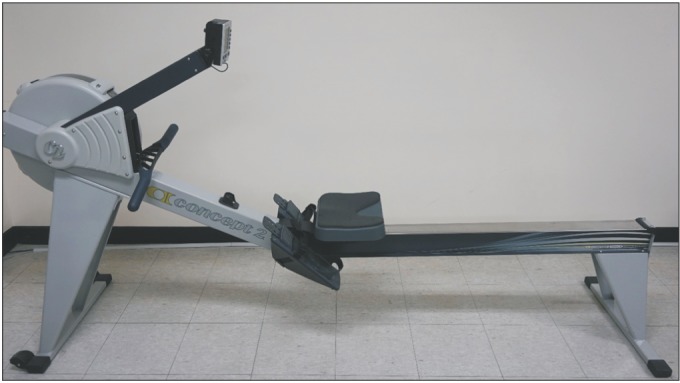Ann Rehabil Med.
2015 Aug;39(4):592-598. 10.5535/arm.2015.39.4.592.
Effects of Indoor Rowing Exercise on the Body Composition and the Scoliosis of Visually Impaired People: A Preliminary Study
- Affiliations
-
- 1Department of Physical Medicine and Rehabilitation, Hallym University Chuncheon Sacred Heart Hospital, Hallym University College of Medicine, Chuncheon, Korea. choi.eunhi@gmail.com
- KMID: 2148230
- DOI: http://doi.org/10.5535/arm.2015.39.4.592
Abstract
OBJECTIVE
To evaluate the effects of rowing exercise on body composition, laboratory data, fitness and scoliosis in visually impaired people. The majority of visually impaired people do not participate in active sports due to efficiency and safety issues. Rowing is a safe whole-body exercise with aerobic and anaerobic components.
METHODS
Twenty subjects were recruited from among those admitted to a facility for visually impaired people (16 men and 4 women). Laboratory data, body composition, physical fitness, Cobb's angle, and fall index were checked before and after 6 weeks (5 days a week) of indoor rowing using Concept2 Model E.
RESULTS
After the training, fat mass and total body fat percent decreased significantly. In the fitness test, back strength and trunk flexion score increased significantly. Laboratory data showed significant increases in serum protein and albumin and decreases in low-density lipoprotein (LDL) cholesterol. There were 9 subjects with scoliosis and after the training Cobb's angle decreased by 1.11degrees+/-1.55degrees, though this was not statistically significant.
CONCLUSION
Visually impaired people frequently have abnormal body composition, low physical fitness, and scoliosis. A rowing exercise program can be helpful, with a positive effect on body composition and physical fitness; however, with respect to scoliosis, we need an earlier intervention program in visually impaired people.
Keyword
MeSH Terms
Figure
Reference
-
1. Steinman BA, Vasunilashorn S. Biological risk of older adults with visual impairments. J Nutr Health Aging. 2011; 15:296–302.
Article2. Paek DH, Lee IK. The current situations and perception of physical education in special schools for students with visual impairments. J Adapt Phys Act Exerc. 2007; 15:91–113.3. Lee YC, Choi MR, Jeoung BJ. Prevalence of obesity in students with intellectual disability and visual impairment at special school. J Korean Phys Edu Assoc Girls Women. 2011; 25:195–205.4. Catanzariti JF, Salomez E, Bruandet JM, Thevenon A. Visual deficiency and scoliosis. Spine (Phila Pa 1976). 2001; 26:48–52. PMID: 11148645.
Article5. Giagazoglou P, Amiridis IG, Zafeiridis A, Thimara M, Kouvelioti V, Kellis E. Static balance control and lower limb strength in blind and sighted women. Eur J Appl Physiol. 2009; 107:571–579. PMID: 19701648.
Article6. Jones GC, Crews JE, Danielson ML. Health risk profile for older adults with blindness: an application of the International Classification of Functioning, Disability, and Health framework. Ophthalmic Epidemiol. 2010; 17:400–410.
Article7. Uusi-Rasi K, Sievaen H, Rinne M, Oja P, Vuori I. Bone mineral density of visually handicapped women. Clin Physiol. 2001; 21:498–503. PMID: 11442582.
Article8. Chen CC, Lin SY. The impact of rope jumping exercise on physical fitness of visually impaired students. Res Dev Disabil. 2011; 32:25–29.
Article9. US Department of Health and Human Services. Physical activity and health: a report of the Surgeon General. Atlanta, GA: Department of Health and Human Services;1996.10. Mastu J, Juima J, Juima T. Monitoring of performance and training in rowing. Sports Med. 2005; 35:597–617.11. Kuo FC, Wang NH, Hong CZ. Impact of visual and somatosensory deprivation on dynamic balance in adolescent idiopathic scoliosis. Spine (Phila Pa 1976). 2010; 35:2084–2090. PMID: 20975488.
Article12. Park JJ, Kim IK, Park HK, Kim SS. The effect of aerobic exercise program on cardiorespiratory function of individuals with visual disability. J Adapt Phys Act Exerc. 2001; 9:117–129.13. Han DY, Seo TB, Lee DH, Byun KS, Jeong IG, Lee HH, et al. Analysis on ventilatory threshold and muscle fatigue in an adolescent with blindness during cycle ergometer exercise. J Sport Leis Stud. 2009; 38:709–718.
Article14. Park KY, Kim HC, Kim YB, Lee YA, Jeong YT, Kim DW. Analysis of body composition, blood lipid and Ghrelin concentration of obese mentally weak children according to exercise execution of rowing machine and treadmill. J Rehabil Res. 2012; 16:225–246.15. Kotwicki T, Chowanska J, Kinel E, Czaprowski D, Tomaszewski M, Janusz P. Optimal management of idiopathic scoliosis in adolescence. Adolesc Health Med Ther. 2013; 4:59–73. PMID: 24600296.
Article16. Mordecai SC, Dabke HV. Efficacy of exercise therapy for the treatment of adolescent idiopathic scoliosis: a review of the literature. Eur Spine J. 2012; 21:382–389. PMID: 22065168.
Article17. Grivas TB, Wade MH, Negrini S, O'Brien JP, Maruyama T, Hawes MC, et al. SOSORT consensus paper: school screening for scoliosis. Where are we today? Scoliosis. 2007; 2:17. PMID: 18039374.
Article18. Caldwell JS, McNair PJ, Williams M. The effects of repetitive motion on lumbar flexion and erector spinae muscle activity in rowers. Clin Biomech (Bristol, Avon). 2003; 18:704–711.
Article
- Full Text Links
- Actions
-
Cited
- CITED
-
- Close
- Share
- Similar articles
-
- Effects of Rowing Exercise on Prevention of Metabolic Syndrome and Sarcopenia for Senior People
- Screening of Visually Impaired Children for Health Problems
- Development of a Motor Driven Rowing Machine with Automatic Functional Electrical Stimulation Controller for Individuals with Paraplegia; a Preliminary Study
- Qualitative Study for Barriers for Medication and Health Care Service Use among the Visually Impaired and Hearing Impaired in Korea
- The Effect of Regular Exercise Program on Body Composition and Body Image in Adults Using One Fitness Center


